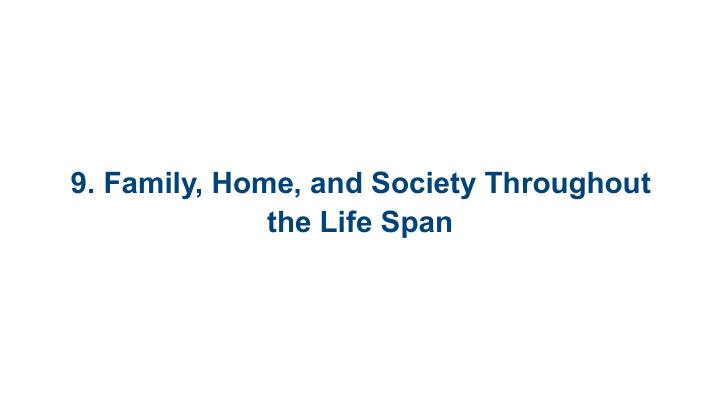



9. Family, Home, and Society Throughout the Life Span
9.1 Family Structures 9.2 Family Relations 9.3 Parenting Styles 9.4 Bronfenbrenner’s Ecological Perspective
9.5 Multicultural Perspectives 9.6 Social and Class Influences
9.7 Abuse and Neglect 9.8 Media and Technology 9.9 Death and Dying
9.1 Family Structures
Who heads the family? • Married heterosexual couple • Single parent • Parent + stepparent
Who heads the family? • Multigenerational adults • Unwed partners • Same-sex couple • Any of above with adoptees
9.2 Family Relations
Interrelationships • Couple relationship • Define quality/ atmosphere of family life • Marital satisfaction lowest when children very young
Interrelationships • Sibling relationships • Attachment, rivalry, etc. • Influenced by culture
9.3 Parenting Styles
Ways to parent • Authoritarian: top-down rules and decisions; goal = compliance • Permissive: friendly, allowing, forgiving; goal = harmony, creativity
Ways to parent • Authoritative = discussion, explaining, consequences; goal = self-management
Consequences • Authoritarian ➔ withdrawn/isolated or rebellious • Permissive ➔ social, academic, emotional adjustment problems • Authoritative ➔ success and popularity
9.4 Bronfenbrenner’s Ecological Perspective
Ecology of family • Widening circles of influence • Relationships within family, extended family • Neighborhood, culture, society • Time, place, economics, politics
9.5 Multicultural Perspectives
Culture affects family • Determines dominant parenting style • Defines gender roles • Influences expectations, obligations toward siblings
Culture affects family • Influences goals of child-rearing • SES influences leisure time, disposable income, etc.
Ethnic identity • Distinct from racial identity • Related to self-concept and self-identity • Begins in adolescence • Related to cognitive gains, ability to think abstractly
Ethnic identity • Think about relation to group • Think about group’s relation to other groups • Solidifies in adulthood ➔ Identification with ethnic group changes throughout life span
9.6 Social and Class Influences
Influence of SES • Low SES stress on family: economic, nutritional, resources • Early vocabulary affected by low SES from differences in verbal stimulation • Malnutrition ➔ stunted growth and delayed menarche
Influence of SES • Low SES males especially at risk for social problems and school retention • Downward spiral: low motivation, low achieving, behavior problems in/out of school
9.7 Abuse and Neglect
Physical abuse • Force that can harm health, survival, development or dignity • Hit, kick, shake, scratch, pinch, scald, burn forced positions or ingestion
Physical abuse ➔ Personality disorders, PTSD, depression, anxiety, aggression, substance abuse, and eating disorder
Sexual abuse • Pressure to engage in sexual activities, indecent exposure, display pornography, sexual/genital contact ➔ Guilt, PTSD, fears, sexual dysfunction, addictions, eating/ personality disorders
Psychological abuse • Isolate, terrorize, deny emotional response, humiliate to convey worthlessness ➔ Self-blame, abnormal attachment, internalization, learned helplessness
Neglect • Lack of care, nourishment, supervision • Absenteeism, clothing lack, medical and dental needs, poor hygiene ➔ Physical delays, poor social and relational skills, poor executive function
9.8 Media and Technology
Technology: child • Screen time • How much at each age? • Instead of play/interaction • Learning • Pro: “edutainment” • Con: Bandura’s clown aggression study
Technology: adolescent • Connection • Collaborative learning • Social media to connect for friendship, activism • Alienation • Social media to bully • Instead of social skills
9.9 Death and Dying
End-of-life choices • Dying at home • In hospital with medical care • Advance care directive and DNR • In hospice with palliative care • Euthanasia?
Grieving • Kubler-Ross stages • Denial • Anger • Bargaining • Depression • Acceptance
Grieving • Criticism: some do not go through stages in order
Recommend
More recommend